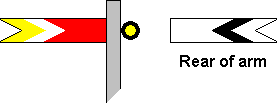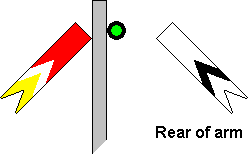Republic of Ireland
(Page 1 of 3)
Signalling in Ireland had naturally conformed to British practice prior to the formation of the Irish Free State in 1922. After independence was gained, the Irish developed new signalling practices of their own while new ideas in Great Britain were not necessarily followed in Ireland.
In common with the Great Western Railway in Great Britain, the Irish railways failed to adopt the upper quadrant semaphore signal, and to this day the lower quadrant type remains standard. From 1946 (and slightly earlier on Ireland's Great Northern Railway), the original red 'caution' lenses in distant signals were changed to yellow, although the arms continued to be coloured red (see [2.85]).
|
Some fixed distant signals take the form of a square white board bearing a picture of a red distant arm, with a yellow lamp mounted above [IE.1]. These are known as 'banner' distants.
|
 |
[IE.1] Banner Distant Signal.

|
|
Since 1996, most semaphore signals have been fitted with a new style of arm incorporating a highly reflective left-hand end. During darkness, this appears as a bright coloured light, red for a stop signal and yellow for a distant signal. The yellow end of the distant signal arm [IE.2 & IE.3] compensates for the fishtail and chevron being difficult to discern in the reflective glow.
 |
 |
[IE.2] Semaphore Distant Signal ('on').

|
[IE.3] Semaphore Distant Signal ('off').
|
|
A newer form of 'banner' distant depicts a yellow-ended distant signal arm on a black background [IE.4].
|
 |
|
[IE.4] Banner Distant Signal.
|
|
|
A review of braking distances at worked level crossing distant signals revealed that many were deficient. As a short-term remedy, a 'braking point marker board' was installed at certain locations from 2002. This board shows a simplistic representation of a semaphore signal (with its arm in both 'on' and 'off' positions) on a blue background [IE.5]. When a train reaches this position, the driver must begin braking unless he or she can see that the distant signal ahead is 'off'.
|
 |
[IE.5] Braking Point Marker Board.

|
|
Colour light signals showing the four main British aspects have been in use in Ireland since the 1930s, but the double yellow aspect was uncommon until the 1980s. Flashing aspects are not used in the Republic of Ireland.
A few examples of the circular type of disc shunting signal (see [4.46 & 4.48]) can be seen in Ireland. The most prevalent form of mechanical shunting signal, however, is square in shape [IE.6 & IE.7], and despite this they are still referred to as 'discs'.
 |
 |
|
[IE.6] Disc Shunting Signal with Square Face ('on').
|
[IE.7] Disc Shunting Signal with Square Face ('off').
|
In common with British practice, disc signals that can be passed while in the 'on' position are provided with a yellow band and light instead of the usual red. The background colour of the Irish yellow discs remains as white [IE.8 & IE.9], in contrast to the black background that became standard in Britain for these signals (see [4.94 & 4.95]).
 |
 |
[IE.8] Yellow Disc Shunting Signal with Square Face ('on').

|
[IE.9] Yellow Disc Shunting Signal with Square Face ('off').
|
Early power signalling schemes have included miniature colour light shunting signals or position light shunting signals showing one red and one white light horizontally for 'on' (see [4.87]) and two white lights at 45° for 'off' (see [4.74]).
In Ireland, shunting signals that are associated with (i.e. co-located with) a main signal are normally mounted at ground level, but they can be elevated if the signal concerned is located on a station platform or mounted on a gantry. In the UK, position light shunting signals associated with a main signal are only equipped to display a 'proceed' aspect and are otherwise extinguished. In Ireland, every shunting signal has the ability to show an 'on' aspect, which is displayed even when an associated main aspect at the same signal is cleared. Independent shunting signals facing the direction of travel remain 'on' when a main aspect route is set past them from a main signal on approach. This is contrary to current British practice, although the earliest position light signals in Great Britain (see [4.73]) were operated in that fashion.
In the early 1980s, a novel design of shunting signal was introduced as the new Irish Rail standard, comprising an American type of dwarf position light signal head with four small lenses (three white and one red). The 'on' aspect is identical to the earlier style of position light signal, i.e. one red and one white light, horizontally displayed (see [4.87]). An 'off' aspect is formed by illuminating two of the three white lights, their relative positions giving a directional route indication; thus, there are three possible 'off' aspects [IE.10 - IE.12], and any particular signal may be capable of displaying one, two or all three of them. An alphanumeric route indicator may be provided in addition, to differentiate between different routes in the same general direction (left, right or straight ahead).
 |
 |
 |
|
[IE.10] Directional Position Light Shunting Signal ('off' for left-hand route).
|
[IE.11] Directional Position Light Shunting Signal ('off' for straight-ahead route).
|
[IE.12] Directional Position Light Shunting Signal ('off' for right-hand route).
|
'Shunt limit' boards generally comprise a rectangular red board with the words "shunt limit" in white and a lamp in the centre [IE.13]. This is the most common form, but others exist that are hexagonal or circular in shape or bear alternative lettering, e.g. "limit of shunt" or "LOS". In normal circumstances the lamp has a red lens, but in Ireland, 'shunt limit' boards can be installed on single line railways, in which case a white lens is fitted [IE.14]. A 'shunt limit' board with a white lens may be ignored if it was approached from a signal that exhibited a main 'proceed' aspect.
 |
 |
[IE.13] 'Shunt Limit' Board with Red Light.

|
[IE.14] 'Shunt Limit' Board with White Light.

|
A few of the signal post signs that are standard in Great Britain are also used in Ireland: the diamond sign (see [9.7]), the automatic signal sign (see [9.27]) and the semi-automatic signal sign (see [9.28]).
Where sighting was restricted, a 'repeater' signal would traditionally be installed on approach to the main signal. The repeater signal was of the same form as the signal being repeated and showed the same aspects, but additionally it carried a plate worded "repeater" [IE.15]. Since 2000, Irish Rail has adopted the UK-style banner repeater signal for new works (see [7.55 & 7.56]).
One sign that has no equivalent in Great Britain is the "call on" plate, first introduced in 2011 at Dublin Heuston. This comprises a yellow plate with the words "call on" [IE.16] and is fitted below a position light signal that controls the entrance to a call-on route, as well as any facing position light signals within the route. It indicates to drivers of passenger trains that they are permitted to proceed on the authority of a 'proceed' aspect at the position light signal concerned (see [IE.10 - IE.12]).
 |
 |
[IE.15] "Repeater" Plate.

|
[IE.16] "Call On" Plate.
|

















